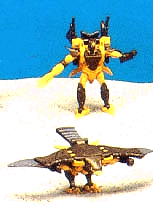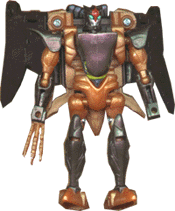 BEAST
WARS: TOY REVIEW
BEAST
WARS: TOY REVIEW
Name: AIRAZOR
Allegiance: Maximal
Function: Aerial Reconnaissance
Beast Mode: Peregrine falcon
Average Price: 25 AUD (with video)

BEAST MODE
Length: 10.5cm
Wingspan: 19cm
Colour scheme: primarily brown with white accents and
yellow beak and talons. The moulding is superb with various types of feathers
moulded throughout the face, back, wings and tail. A lever at the rear
can be pulled to make the wings move forward and back. Two blades fold
out from each wing, forming an attack mode. However, this is a really impractical
and stupid attack gimmick. It's primary disadvantage is it's lack of range.
The blades close in a pincer formation and connect just in front of the
head. Hence, she'd have to be withing pecking distance to use it. Secondly,
she wouldn't be able to fly, since she can't flap her wings whilst using
the weapon. It's little wonder why she never uses it in the TV show. Furthermore,
after pulling the blades out, mechanical parts are exposed, revealing Airazor's
true robotic nature - hence the disguise gimmick of her beast mode would
be useless.. then again, even if the parts weren't exposed, you don't see
too many falcons flying around with blades sticking out of their wings.
But other than the silly attack mode, the beast mode looks great.
TRANSFORMATION TO ROBOT MODE
Height: 9.5cm
A very superb figures, the beast and robot parts blend
with each other nicely. Although the toy is somewhat back-heavy in this
mode, the figure can be easily stood by adjusting the ankles. Two features
which I really like are the robot fists and a hand held gun - with guns
being a rarity in the Beast Wars line, especially during the early years.
Despite the fantastic look of this toy, my only minor complaint would be
that it doesn't look feminine at all. One reason why Takara was able to
market the toy as a male character in Japan. Other than that, a very slick
looking robot with 13 points of articulation.
ROBOT MODE
Height: 9.5cm
A very superb figures, the beast and robot parts blend
with each other nicely. Although the toy is somewhat back-heavy in this
mode, the figure can be easily stood
by adjusting the ankles. Two features which I really
like are the robot fists and a hand held gun - with guns being a rarity
in the Beast Wars line, especially during the
early years. Despite the fantastic look of this toy,
my only minor complaint would be that it doesn't look feminine at all.
One reason why Takara was able to market
the toy as a male character in Japan. Other than that,
a very slick looking robot with 13 points of articulation.
RUB STICKER LOCATION
Under the tail.
OVERALL
A fantastic looking toy with as much poseability as most
other Beast Wars Transformers.
VARIATIONS
The brown was replaced with a darker brown, the white accents
with silver, yellow was substituted with orange. All the new colours were
also metallic. This toy was also packaged with a VHS video tape containing
the episodes "Aftermath" and "Coming of the Fuzors Part I". The new colour
scheme is great, as it is far closer to the colour scheme from the TV series.
I recommend this version over the original.
 Above: Video pack Airazor. Photo courtesy of Benson
Yee.
Above: Video pack Airazor. Photo courtesy of Benson
Yee.
BEAST TRIVIA
Family: Falconidae
Genus: Falco
Species: peregrinus
Also known as the duck hawk, the peregrine falcon is a bird of prey
which occurs worldwide but has become rare throughout almost all of its
ranges. Bluish gray above with underparts white to yellowish with black
barring, peregrines range from about 33 to 48 centimetres long. They are
strong and fast. They fly high and dive at tremendous speeds, striking
with clenched talons and killing by impact. The prey includes ducks and
shorebirds. Peregrines inhabit rocky open country near water where birds
are plentiful. The usual nest is a mere scrape on a ledge, high on a cliff.
The clutch is two to four reddish brown eggs. The young fledge in five
or six weeks.
The chief cause of the peregrine falcon's decline has been the buildup
of chlorinated hydrocarbons (which are used in such pesticides as DDT)
in the bird's food sources. The chemicals become concentrated in the peregrine's
tissues and interfere with reproduction, particularly by causing the thinning
of eggshells and the resultant loss of eggs. Habitat destruction has also
played a role in the falcon's population decline.
The American peregrine (Falco peregrinus anatum), which once
bred from Hudson Bay to the southern United States, is listed as endangered
in the Red Data Book. It is extinct in the eastern U.S. and eastern
boreal Canada. The Alaskan peregrine is also classified as endangered,
as well as several other sub species world wide are listed as threatened
or vulnerable.
Peregrines can be bred in captivity and programmes have been instituted
to release captive-bred peregrines into areas where the bird has become
extinct. The ultimate success of such programmes, however, may depend on
the elimination of chlorinated hydrocarbons from the peregrine falcon's
food chain.
Bibliography: Encylcopaedia Britannica
Email
Back
 BEAST
WARS: TOY REVIEW
BEAST
WARS: TOY REVIEW
